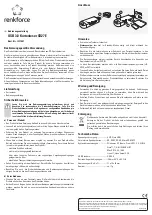
Power Over Camera Link (PoCL)
PoCL Safe Power
Version G.5
BitFlow, Inc.
NEO-6-3
6.3 PoCL Safe Power
The PoCL specification is fairly simple in that it only described the amount of power
that should be provided, which CL cable lines the power should be applied and that
an over current protection device should be used on the power lines. It was quickly
realized, however, that this specification was inadequate for the real world. This sim-
ple specification could lead to many different kinds of problems if proper frame grab-
ber/cable/camera combinations were not always used. In the real world, engineers
use whatever resource they have at hand to solve problems. With PoCL specification
as it stood, many combinations could result in damage equipment.
The camera link committee decided to add a optional component to the specification
called “Safe Power”. The safe power system would take an active role in testing any
equipment connected and make sure everything was PoCL compliant before apply-
ing power. The goal being if any legacy equipment was plugged into a PoCL frame
grabber, the power would never be applied because the frame grabber could detect
that the equipment was not PoCL compliant.
The Safe Power system uses a state machine which proceeds though a number of
tests before applying power. If any of the tests fail, the power is not applied. Also, if a
power camera is removed, the safe power system detects this situation and goes back
to a non-powered state. Figure 6-1 shows the state of the PoCL safe power system.
It is important to understand the board powers up with the PoCL system turned off.
The PoCL system will not start up, and no power will be applied to any connector until
the register POCL_EN is set to 1. This is an extra safety feature that gives the user com-
plete control PoCL system. Also, this lets the board act as a normal CL frame grabber
in situations where non-PoCL camera is being used.
The principle of safe power is that the state machine (once it is turned on) first tries to
detect if a PoCL camera is attached or not. This is done by detecting the impedance of
the camera with a very small voltage. Non-PoCL equipment will test one way and
PoCL equipment will test another way. Once it is determined that a PoCL camera is
attached, the frame grabber applies power. There is a small waiting time while the
camera boots, then the state machine look for the clock coming back from the cam-
era. If the clock is detected, the state machine goes into running mode. If at any point
in time, the clock is lost (e.g. the camera is disconnected), the system falls back to the
Sense state, looking for a camera. There is a over current circuit which acts like a fuse,
if too much current is detected, the system shuts down power, and the board exits the
PoCL normal state (resets POCL_EN). In order to recover from an over current event,
the POCL_EN bit must be set to 1 again.
Summary of Contents for NEO-PCE-CLB
Page 8: ... TOC 6 BitFlow Inc Version ...
Page 22: ...Virtual vs Hardware Frame Grabbers The Neon NEO 1 12 BitFlow Inc Version G 5 ...
Page 64: ...NTG Control Registers The Neon NEO 3 6 BitFlow Inc Version G 5 ...
Page 90: ...PoCL Control Registers The Neon NEO 6 6 BitFlow Inc Version G 5 ...
Page 266: ...Power Consumption The Neon NEO 12 6 BitFlow Inc Version G 5 ...
Page 294: ...NEO PCE DIF I O Connector Pinout P3 The Neon NEO 13 28 BitFlow Inc Version G 5 ...
Page 300: ...Index BitFlow Inc ...
















































